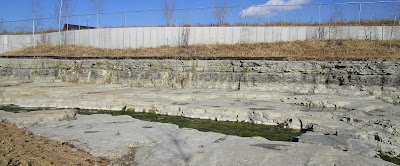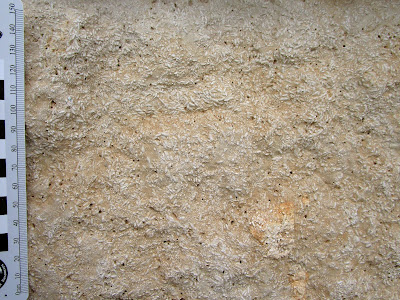For this year's annual focus on a fossil group in National Park System units, I am going to pay my Internet cat tax and present a quick look at the fossil felids of the parks. If you're not familiar with the history of Felidae, it may come as a surprise that cats are a relatively recent innovation. They have only a few tens of millions of years under their collective belts, and didn't arrive in North America until
Pseudaelurus in the early Miocene. (Note: barbourofelids and nimravids may give off saber-toothed cat vibes, but they aren't Felidae.)
It turns out that there are 24 NPS units with cat body or trace fossils. All
of the records, unsurprisingly, are early Miocene in age or younger. The great
majority are Quaternary (concerning the question of when to cut off the
paleontological record, caves don't discriminate if you happen to be 11,000 years old
rather than 12,000 years old, and neither do we): only seven of the 24 park
units have pre-Q cats. These are Big Bend National Park, Death Valley NP, Hagerman Fossil
Beds National Monument, John Day Fossil Beds NM, Lake Mead National Recreation Area, Mojave National Preserve, and Niobrara
National Scenic River.
 |
These maps are so much easier to make now that I have one file with all of the parks as points, and I can just turn them on and off. 1. John Day Fossil Beds National Monument; 2. Oregon Caves NM; 3. Lava Beds NM; 4. Hagerman Fossil Beds NM; 5. Yellowstone National Park; 6. Great Basin NP; 7. Death Valley NP; 8. Tule Springs Fossil Beds NM; 9. Lake Mead National Recreation Area; 10. Mojave National Preserve; 11. Joshua Tree NP; 12. Grand Canyon NP; 13. Chaco Culture National Historical Park; 14. White Sands NP; 15. Carlsbad Caverns NP; 16. Guadalupe Mountains NP; 17. Big Bend NP; 18. Amistad NRA; 19. Waco Mammoth NM; 20. Niobrara National Scenic River; 21. Ozark National Scenic Riverways; 22. Chickamauga & Chattanooga National Military Park; 23. Potomac Heritage National Scenic Trail; 24. Valley Forge NHP.
|
Geographically the sites are concentrated in the
southwestern US; in fact, 15 of the sites are in Arizona, California, Nevada,
New Mexico, or Texas. This seems to say something about cat biogeography,
given these are mostly Quaternary sites and the NPS has a pretty good
Quaternary record in terms of geographic spread. I wouldn't base a thesis on
it or anything, though.
It's not stated on the map, but the Quaternary record is heavy on caves; a
dozen of the records are from caves or rock shelters. These included
significant records at Carlsbad Caverns NP, Grand Canyon NP, Guadalupe
Mountains NP, Potomac Heritage NST (Cumberland Bone Cave),
and Valley Forge NHP (Port Kennedy Bone Cave).
Most of the records are body fossils, but at least three have cat trace
fossils: tracks at Death Valley NP and White Sands NP, and tracks and cave
scratches at Chickamauga & Chattanooga NMP. One of these sites has yielded a
track type specimen, Felipeda scrivneri Sarjeant et al. (2002) from
Death Valley NP. There are also eight fossil felid species named from body
fossils discovered within or potentially within NPS areas (all named before the units were established):
-
Felis lacustris Gazin (1933) from Hagerman (now
Puma lacustris)
-
Machairodus? hesperus Gazin (1933) from Hagerman (now
Megantereon hesperus)
-
Felis augustus Leidy (1872) possibly from Niobrara (now
Panthera onca [augusta], and Pleistocene instead of Miocene in
age)
-
Felis (Pseudaelurus) intrepidus Leidy (1858) possibly
from Niobrara (now Pseudaelurus intrepidus)
-
Crocuta inexpectata Cope (1895) from Valley Forge (now
Miracinonyx inexpectatus)
-
Lynx calcaratus Cope (1899) from Valley Forge (now considered a
synonym of Lynx rufus)
- Smilodon gracilis Cope (1880) from Valley Forge
-
Uncia mercerii Cope (1895) from Valley Forge (now considered a
synonym of Smilodon gracilis)
Attaining consensus on cat taxonomy and nomenclature can be like, well,
herding cats. It doesn't help that it can be difficult to tell cats apart; see
a record of "Panthera onca" at Carlsbad Caverns NP becoming
Panthera atrox (Kottkamp et al. 2022), and "Puma concolor"
fossils at Grand Canyon NP becoming Miracinonyx trumani (Hodnett et al.
2022; take the skull for a spin here). Nevertheless, the Quaternary sample can be divided among seven
species or species groups. Three are extinct:
-
American cheetah (Miracinonyx inexpectatus and M. trumani):
found at Carlsbad, Grand Canyon, Potomac Heritage, and Valley Forge
-
American lion (Panthera atrox): found at Carlsbad, Potomac Heritage,
and Tule Springs
-
Saber-toothed cats (Smilodon spp.): found at Potomac Heritage, Tule
Springs, Valley Forge, and Waco Mammoth
Two are still around but not this far north:
-
Jaguar (Panthera onca): found at Lava Beds, Oregon Caves, Ozark,
Potomac Heritage, and Valley Forge (these are all pretty far north for something we associate with tropical jungles!)
-
Jaguarundi (Herpailurus yagouaroundi): found at Valley Forge
Finally, two are still found in the United States:
-
Bobcat (Lynx rufus, with allowance for Lynx sp.): Amistad,
Carlsbad Caverns, Chaco Culture*, Great Basin*, Grand Canyon, Guadalupe
Mountains, Joshua Tree*, Lava Beds, Tule Springs, Valley Forge, and Yellowstone*
(*=Holocene only)
-
Cougar/mountain lion/puma (Puma concolor): Carlsbad Caverns, Chaco
Culture*, Guadalupe Mountains, and Tule Springs
The most species-rich sites are:
-
Carlsbad Caverns NP (American cheetah, American lion, bobcat, cougar)
-
Hagerman Fossil Beds NM (American cheetah, Homotherium sp. [a
saber-toothed cat], Lynx rexroadensis,
Megantereon hesperus [or cultridens; another saber-toothed
cat], Puma lacustris)
-
Tule Springs Fossil Beds NM (American lion, bobcat, cougar, saber-toothed
cat)
-
Valley Forge NHP (American cheetah, bobcat, jaguar, jaguarundi,
saber-toothed cat)
Of these four, the Hagerman assemblage is Pliocene, the Valley Forge assemblage is middle Pleistocene, and the other two are late Pleistocene. In the Pleistocene, at least, a robust cat assemblage may include a big lion-type cat, a saber-toothed cat, a smaller big cat (but apparently not cougars and jaguars at the same place), and a bobcat-sized cat.
Felids are relatively uncommon compared to the other big terrestrial carnivorans. Fossil dogs and bears are more widely distributed in NPS units than cats. Furthermore, all but one NPS assemblage that has cats also has dogs, bears, or both (the exception being the Pliocene tracks of Death Valley NP). These groups, though, are for another time...
References
Cope, E. D. 1880. On the extinct cats of America. American Naturalist 14(12):833–858.
Cope, E. D. 1895. The fossil Vertebrata from the fissure at Port Kennedy. Proceedings of the Academy of Natural Sciences of Philadelphia 47:446–450.
Cope, E. D. 1899. Vertebrate remains from Port Kennedy bone deposit. Journal of the Academy of Natural Sciences of Philadelphia, 2nd series, 11(3):193–286.
Gazin, C. L. 1933. New felids from the upper Pliocene of Idaho. Journal of
Mammalogy 14:251–356.
Hodnett, J. P., R. White, M. Carpenter, J. Mead, and V. L. Santucci. 2022.
Miracinonyx trumani (Carnivora; Felidae) from the Rancholabrean of
the Grand Canyon, Arizona and its implications on the ecology of the
“American cheetah.”
New Mexico Museum of Natural History Bulletin 88:157–186.
Kottkamp, S., V. L. Santucci, J. S. Tweet, R. D. Horrocks, and G. S. Morgan.
2022.
Pleistocene vertebrates from Carlsbad Caverns National Park, New Mexico. New Mexico Museum of Natural History and Science Bulletin 88:267–290.
Leidy, J. 1858. Notice of remains of extinct Vertebrata, from the valley of the Niobrara River, collected during the exploring expedition of 1857, in Nebraska, under the command of Lieut. G. K. Warren, U.S. Top. Eng., by Dr. F. V. Hayden, Geologist to the expedition. Proceedings of the Academy of Natural
Sciences of Philadelphia 10:20–29.
Leidy, J. 1872. Remarks on some extinct vertebrates. Proceedings of the
Academy of Natural Sciences of Philadelphia 24:38–40.
Sarjeant, W. A. S., R. E. Reynolds, and M. M. Kissell-Jones. 2002. Fossil
creodont and carnivore footprints from California, Nevada, and Wyoming. Pages
37–50 in R. E. Reynolds, editor. Between the Basins: Exploring the western
Mojave and southern Basin and Range Province. California State University,
Fullerton, California.























_crop.jpg)
_crop.jpg)
_crop.jpg)





